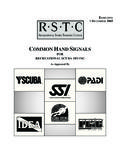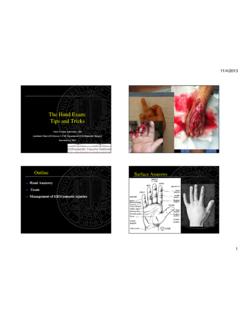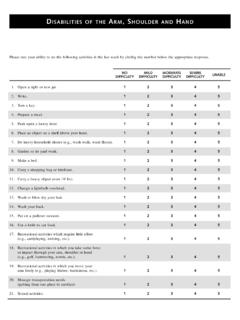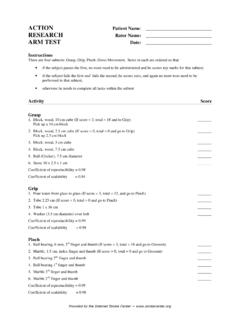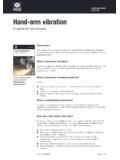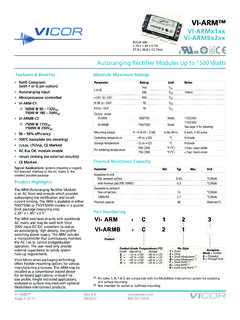Transcription of Guide to good practice on Whole-Body Vibration - …
1 EU good practice Guide WBV WBV good practice Guide English Page 1 12/06/2006 Guide to good practice on Whole-Body Vibration Non-binding Guide to good practice with a view to implementation of Directive 2002/44/EC on the minimum health and safety requirements regarding the exposure of workers to the risks arising from physical agents (vibrations). EU good practice Guide HAV CONTENTS WBV good practice Guide English Page 2 12/06/2006 CONTENTS Contents ..2 Foreword ..4 Chapter 1 Introduction ..6 Chapter 2 Evaluation of risk ..10 The basics of risk assessment ..11 Determining exposure duration ..15 Determining Vibration magnitude.
2 16 Use of manufacturer s emission Use of other data sources ..17 Measurement of Vibration Calculating daily Vibration A(8) and VDV daily exposure evaluation ..20 Uncertainty of daily exposure Chapter 3 Avoiding or reducing exposure ..22 Developing a control strategy ..23 Consultation and Participation of Workers ..25 Risk controls ..26 Substitution of other working Equipment Purchasing Task and process design ..27 Collective measures ..28 Training and information to workers ..28 Work Maintenance ..29 Suspension seats ..29 Vibration monitoring and reassessment ..31 How do I know if my Whole-Body Vibration controls are working?
3 31 When do I need to repeat the risk assessment?..31 Chapter 4 Health Surveillance ..32 When is health surveillance required?..33 EU good practice Guide HAV CONTENTS WBV good practice Guide English Page 3 12/06/2006 What recording is required?..33 What to do if injury is identified? ..33 Annex A Summary of responsibilities defined by Directive 2002/44/EC ..35 Annex B What is Vibration ? ..37 Annex C Health risks, signs and Annex D Tools for calculating daily Annex E Daily exposure Worked Annex F Health Survellance techniques ..56 Annex G Glossary ..57 Annex H Bibliography ..58 Index ..65 EU good practice Guide HAV FORWARD WBV good practice Guide English Page 4 12/06/2006 FOREWORD Directive 2002/44/EC of the European Parliament and of the Council on the exposure of workers to the risks arising from physical agents ( Vibration ) seeks to introduce, at Community level, minimum protection requirements for workers when they are exposed, in the course of their work, to risks arising from Vibration .
4 Directive 2002/44/EC gives exposure limit values and exposure action values . It also specifies employers' obligations with regard to determining and assessing risks, sets out the measures to be taken to reduce or avoid exposure and details how to provide information and training for workers. Any employer who intends to carry out work involving risks arising from exposure to Vibration must implement a series of protection measures before and during the work. The Directive also requires the Member States of the EU to put in place a suitable system for monitoring the health of workers exposed to risks arising from Vibration . The evaluation and assessment of risks arising from exposure to Vibration and the implementation of protection measures can be complicated.
5 This non-binding " Guide to good practice " will facilitate the assessment of risks from exposure to Whole-Body Vibration , the identification of controls to eliminate or reduce exposure, and the introduction of systems to prevent the development and progression of injury. This Guide on Whole-Body Vibration , together with its companion Guide on hand-arm Vibration (Hand-arm Vibration non-binding Guide to good practice with a view to implementation of Directive 2002/44/EC on the minimum health and safety requirements regarding the exposure of workers to the risks arising from physical agents (vibrations)), has been prepared under contract VC/2004/0341 for the European Commission Directorate General Employment, Social Affairs and Equal Opportunities.
6 EU good practice Guide WBV ACKNOWLEDGEMENTS WBV good practice Guide English Page 5 12/06/2006 ACKNOWLEDGEMENTS This Guide has been produced by: ISVR: Professor Griffin & Dr Howarth Institute of Sound and Vibration Research University of Southampton, HSL: Mr P M Pitts Health and Safety Laboratory BGIA: Dr S Fischer & Mr U Kaulbars Berufsgenossenschaftliches Institut f r Arbeitsschutz, Germany. INRS: Dr Donati Institut National de Recherche et de S curit , France. HSE: Mr Bereton Health and Safety Executive Under the supervision of: The Working Party Vibration mandated by the Advisory Committee on Safety and Health at Work in cooperation with the European Commission.
7 We would also like to acknowledge the information generated by two EC-funded Projects, which has been used in preparing this Guide : VIBRISKS: Risks of Occupational Vibration Exposures, EC FP5 project no. QLK4-2002-02650. VINET: Research Network on Detection and Prevention of Injuries due to Occupational Vibration Exposures, EC Biomed II project no. BMH4-CT98-3251. EU good practice Guide WBV INTRODUCTION WBV good practice Guide English Page 6 12/06/2006 CHAPTER 1 INTRODUCTION EU Directive 2002/44/EC (the Vibration Directive ) places responsibilities on employers to ensure that risks from Whole-Body Vibration are eliminated or reduced to a minimum (these responsibilities are summarised in Annex A) This Guide is intended to help employers identify hazards relating to Whole-Body Vibration , assess exposures and risks and identify measures for safeguarding the health and safety of workers exposed to Whole-Body Vibration risks.
8 The Guide should be read in conjunction with the Vibration Directive or national legislation that implements the requirements of that Directive. whole body Vibration is caused by Vibration transmitted through the seat or the feet by workplace machines and vehicles (see Annex B). Exposure to high levels of Whole-Body Vibration can present risks to health and safety and are reported to cause or aggravate back injuries (see Annex C). The risks are greatest when the Vibration magnitudes are high, the exposure durations long, frequent, and regular, and the Vibration includes severe shocks or jolts. Work that involves exposure to Whole-Body Vibration occurs commonly in off-road work, such as farming, construction and quarrying, but it can occur elsewhere, for example on the road in lorries and trucks, at sea in small fast boats and in the air in some helicopters.
9 Whole-Body Vibration is not restricted to seated workers such as drivers, but may also be experienced during standing operations such as standing on a concrete crushing machine. Back injury can be caused by ergonomic factors such as manual handling of the load and restricted or awkward postures. These are factors that may be at least as important as the exposure to Whole-Body Vibration . Back injury can, of course, be caused by activities in or out of work unrelated to use of vehicles. In order to tackle successfully the problem of back injury in drivers and operators of mobile machinery it is important to identify and deal with all possible contributing factors together.
10 The Vibration Directive (Directive 2002/44/EC - see Further reading box) sets minimum standards for controlling the risks from Whole-Body Vibration . The Vibration Directive requires that member states of the European Union implement national legislation to implement the requirements of the Directive by 6th July 2005. National legislation may apply more favourable provisions than those required by the Directive, and should not reduce the protection afforded to workers by any pre-existing national legislation. EU good practice Guide WBV INTRODUCTION WBV good practice Guide English Page 7 12/06/2006 The Vibration Directive sets an exposure action value, above which it requires employers to control the Whole-Body Vibration risks of their workforce and an exposure limit value above which workers must not be exposed1: a daily exposure action value of m/s (or, at the choice of the EC Member State, a Vibration dose value of ); a daily exposure limit value of m/s (or, at the choice of the EC Member State, a Vibration dose value of 21 ).

